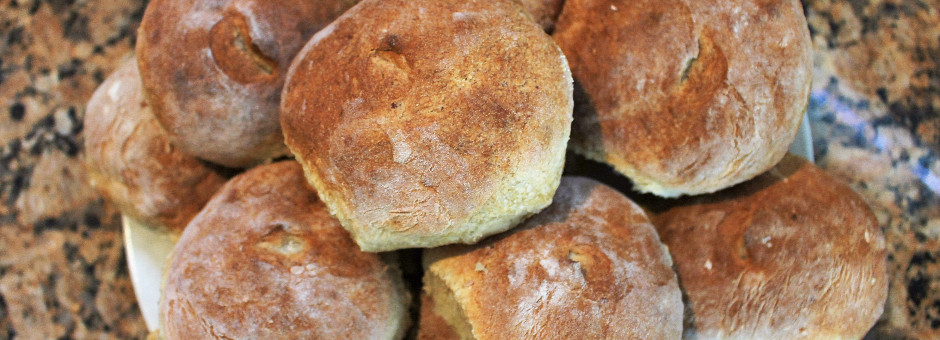Bread
Quick and Easy Sourdough Bread Braided with Sesame Seeds Quick and Easy Whole Wheat Sourdough Bread
Quick and Easy Semolina Bread
Rustic Boule Perfectly Baked in a Dutch Oven
.jpg)
- 2 tablespoons active dry yeast
- 1 tablespoon sugar
- 2 1/2 cups warm water
- 1 tablespoon salt
- 1 tablespoon olive oil Optional, see above)
- About 6 cups (may need a little more or less) unbleached all-purpose or bread flour
- White from 1 egg
- 1 tablespoon water
.jpg)
-c51ce.jpg)
.jpg)
When feeding sourdough with water and flour, some of the original volume is often discarded to make room.
I created this simple technique to make "Quick Everyday Sourdough Bread" to make use of the excess. It’s so quick, easy, and delicious. Neighbors and friends are particularly grateful.
Recipe results in surprisingly great taste with pleasing density and texture the very first try.
What also makes this bread different is an unusually quick and simple two-step assembly process. Only tools needed are a bowl, spatula, dough scraper, and cookie sheet. Bread is table ready in about an hour and a half from scratch.
Oh, and it makes a terrific pizza dough.
- 2 cups hot tap water
- 1 teaspoon sugar
- 1 tablespoon instant dry yeast
- 1 rounded tablespoon Kosher salt
- 3 cups unbleached all-purpose flour
- 1/2 to 3/4 cup sourdough starter
- 2 cups additional flour
- Oil and course cornmeal
Cut, knead, and form dough into desired shapes. Place on a nonstick or lightly oiled cookie sheet dusting with course cornmeal. Lightly brush with water. Slit tops with a sharp knife or razor and place in oven.
Bread is ready when crusty and has a hollow sound when tapped.
Braided Bread Topped with Sesame Seeds…
Made with My Quick and Easy Sourdough Bread Dough, Recipe Above
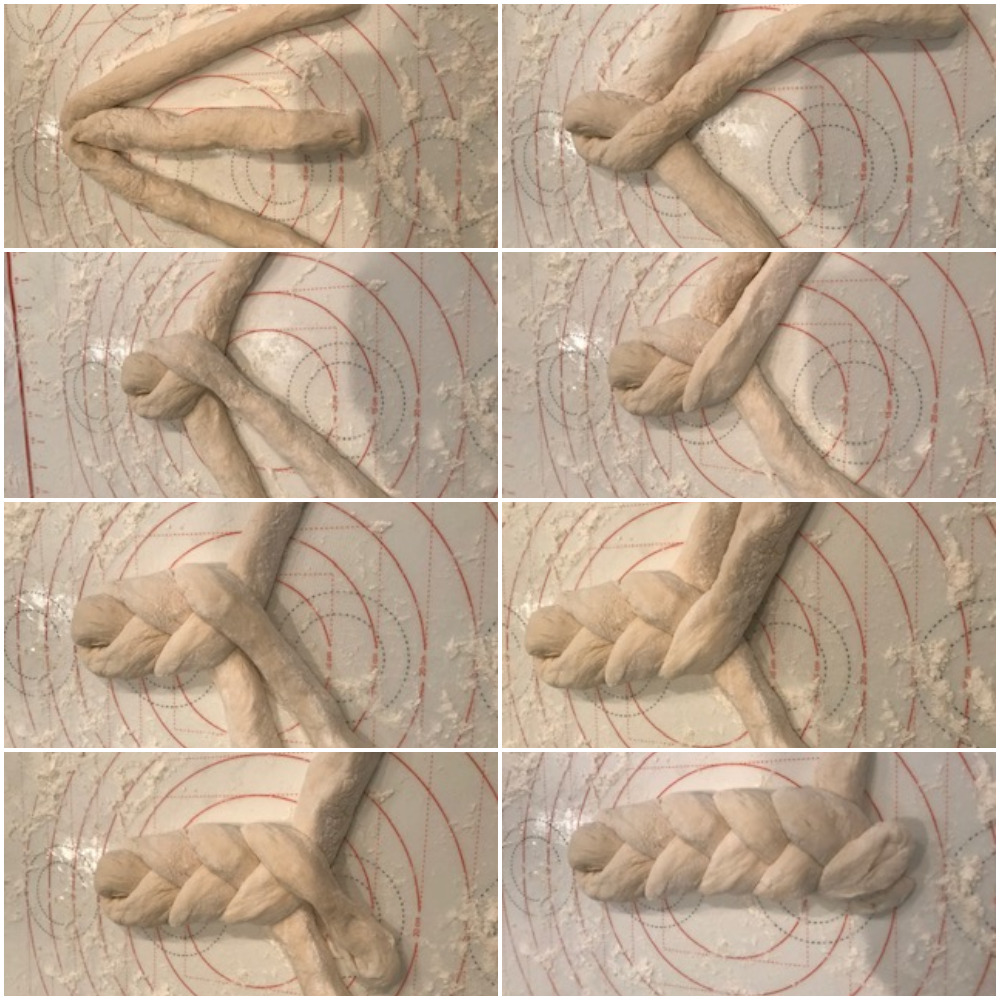
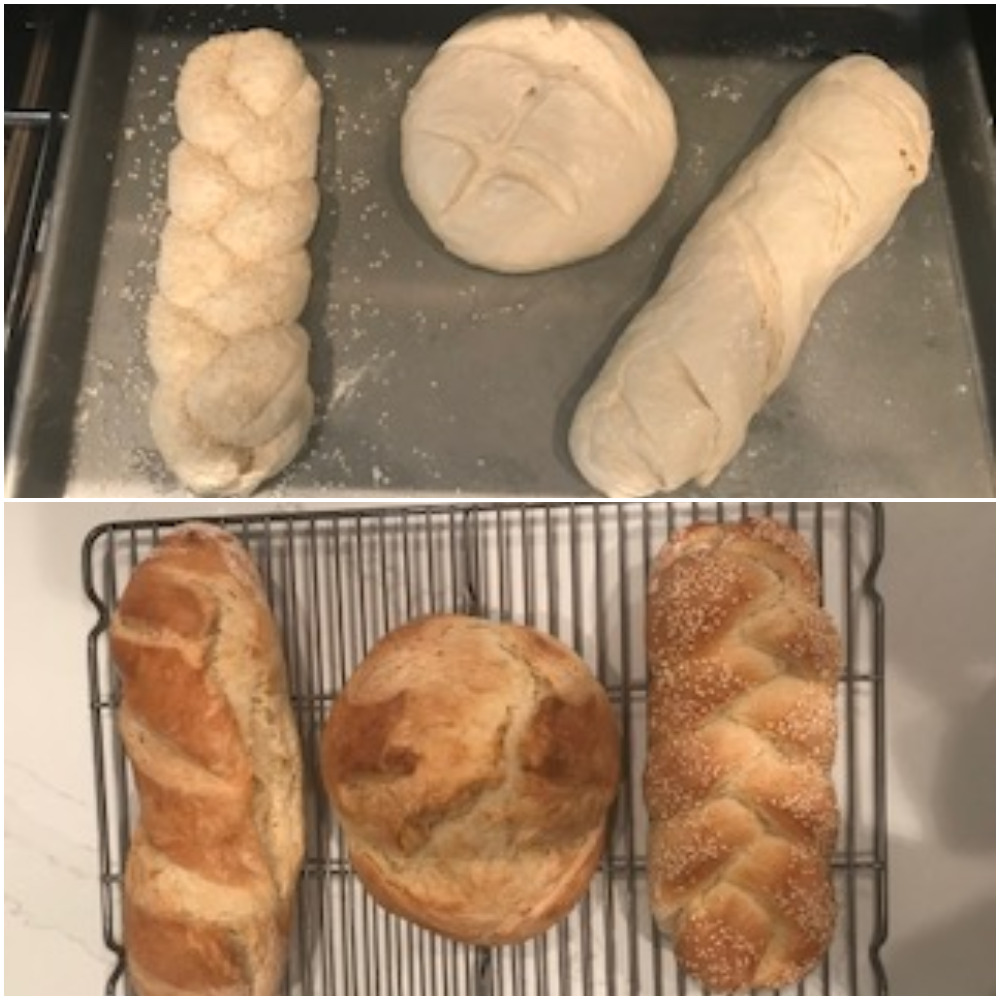
This versatile dough can be formed in a variety of sizes and shapes. Braided bread is elegant yet easy way to impress guests. Toasted sesame seeds also add interesting nutty flavor and crispy texture.
Follow recipe for “Quick and Easy Sourdough Bread. After initial batter doubles in size, additional flour incorporated and kneaded smooth, divide dough in thirds. Preheat oven to 430° direct heat.
For convenience, form one of the thirds into a log and cut again into three equal lengths. One at a time, place dough between hands in prayer position and roll like you would a pencil until each is about 10 inches long.
Don’t fret if uneven. Like magic, irregularities will smooth out as bread cooks and rises. See illustration below.
Three strand braid, dip fingers in water and pinch tips of strands together. Braid as shown. Finish by dipping fingers in water again. Pinch ends and tuck underneath.
Place on a nonstick or lightly oiled cookie sheet dusted with course corn meal. Just before placing in oven, brush top with water and liberally sprinkle with sesame seeds. Baked until loaves are browned and sound hollow when tapped.
Light and Easy Whole Wheat Loaves, Rounds, Rolls, and Perfect Pizza Dough
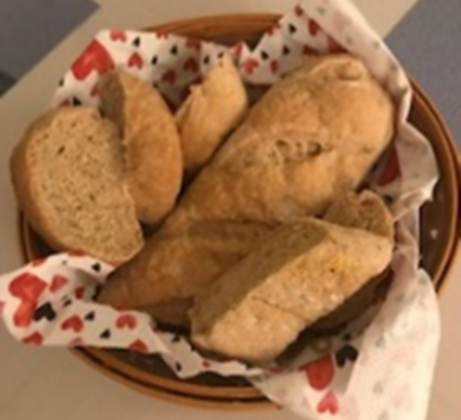
What makes my technique different is an unusually quick and simple two-step process. Recipe first creates a soft batter assembled with only six ingredients, flour, water, yeast, salt, sugar, and a drizzle of olive oil.
Only tools needed are a bowl, spatula, dough scraper, and cookie sheet. Bread is table ready in about an hour and a half from scratch.
Ingredients:
- 2 rounded tablespoons instant dry yeast
- 1/2 tablespoon sugar
- 1rounded tablespoon kosher salt
- 2 cups hot tap water
- 1 cuo whole wheat flour
- 2 cups whole wheat flour
- 2 cups unbleached flour
- Drizzle of olive oil
- Additional 2 cups unblleached flour
- Nonstick spray
- Course cornmeal
Whisk yeast, sugar, and salt in a bowl. Add hot tap water, whole wheat flour and first two cups of unbleached flour. Drizzle with olive oil. Soft batter is made by easily mixing by hand with a rubber spatula.
When smooth, place a sheet of wax paper over top of bowl. Cover with a moistened kitchen towel. Place in a warm location. Dough will double in size in less than 30 minutes.
NOTE: Dough can be formed into a variety of shapes including pizza. For the first time I recommend forming into simple loaves.
Spread about a cup and a half of reserved flour on counter. Empty dough on top. Scrape flour from the periphery over dough all around while kneading. Add additional flour if needed for desired texture. Keep folding, stretching, and kneading until dough is smooth. Shape into a round or log. Cut into 4 equal sized pieces.
Spray cookie sheet with nonstick spray and sprinkle with course corn meal. Place shaped dough on sheet. Use a very sharp knife to make design slits.
Instead of giving the formed loaves a second rise, try this technique. Do not preheat the oven. Set temperature to 420º direct heat, not convection. Place an empty cookie sheet on the bottom shelf.
For extra crispy bread, brush loaves with whisked egg white and water wash. Place cookie sheet in the middle of the oven. As the oven temperature increases to temperature setting, the dough will rise, and the empty bottom cookie sheet baffles direct heat preventing scourging. Bread will be ready in about a half hour when the crust is nicely browned, crusted and the bread sounds hollow when tapped.
Quick and Easy Whole Wheat Sourdough Bread
-d3d94.jpg)
This version of my favorite “Quick and Easy Sourdough Bread” recipe replaces two cups of unbleached flour with whole wheat.
Wheat flour is first moistened with olive oil in a large bowl. One cup of the white flour is stirred with wheat. Water, sugar, dry yeast, kosher salt, and sour dough are added and hand mixed with a spatula creating a relatively soft dough.
Dough is covered and allowed to rise. Once doubled in size, dough is kneaded with additional flour and formed to fit into 2 oiled and cornmeal dusted loaf pans, and oven ready. Second rise isn’t needed. Loafs can also be free formed into rolls, rounds, braids, or any other loafs.
Finished loaf is crusty on the outside tender inside and doesn’t require brushing with water or egg wash before baking.
Ingredients:
- 2 cups whole wheat flour
- ¼ cup olive oil
- 3 cups of unbleached all-purpose separated, 1 and 2 cups.
- 2 cups hot tap water
- 1 teaspoon sugar
- 1 tablespoon instant dry yeast
- 1 rounded tablespoon Kosher salt
- 1/2 to 3/4 cup sourdough starter
- Additional olive oil and course cornmeal
Place 2 cups whole wheat flour in a large bowl. Drizzle with olive oil while folding into flour. Mix in the cup white flour. Add water, sugar, dry yeast, sour dough, and Kosher salt. Combine well with a spatula. Dough will be relatively light.
Spray a sheet of wax paper with nonstick. Gently place sprayed side of wax paper on dough.
Drape top of bowl with a moist towel. Rest in a warm location. Preheat oven to 425° direct heat and position a rack vertically in the center. Add an empty sheet on the lowest shelf as a baffle.
Spread 1 ½ cup of remaining flour onto counter. When dough doubles in size, about a 1/2-hour, empty dough onto flour. With a dough scraper, fold flour from the periphery over dough all around while kneading. Continue kneading until dough loses its stickiness and is uniform; incrementally adding remaining flour as needed. Form into two logs.
Coat 2 loaf pans with olive oil and sprinkle with course corn meal. Place formed dough in pans. With a sharp knife cut slits on dough. Place in oven. Bread will be ready when crusty and has a hollow sound when removed from pan and tappedin, about 30 minutes.
.jpg)
.jpg)
.jpg)
.jpg)
- 2 cups hot tap water
- 1 teaspoon sugar
- 1 tablespoon instant dry yeast
- 2 tablespoons olive oil
- 1 rounded tablespoon Kosher salt
- 2 cups semolina flour
- 1 cup unbleached all-purpose flour
- 1/2 to 3/4 cup sourdough starter
- About 1 cup more semolina flour
- ½ cup more unbleached all-purpose flour
Rustic Boule Perfectly Baked in a Dutch Oven
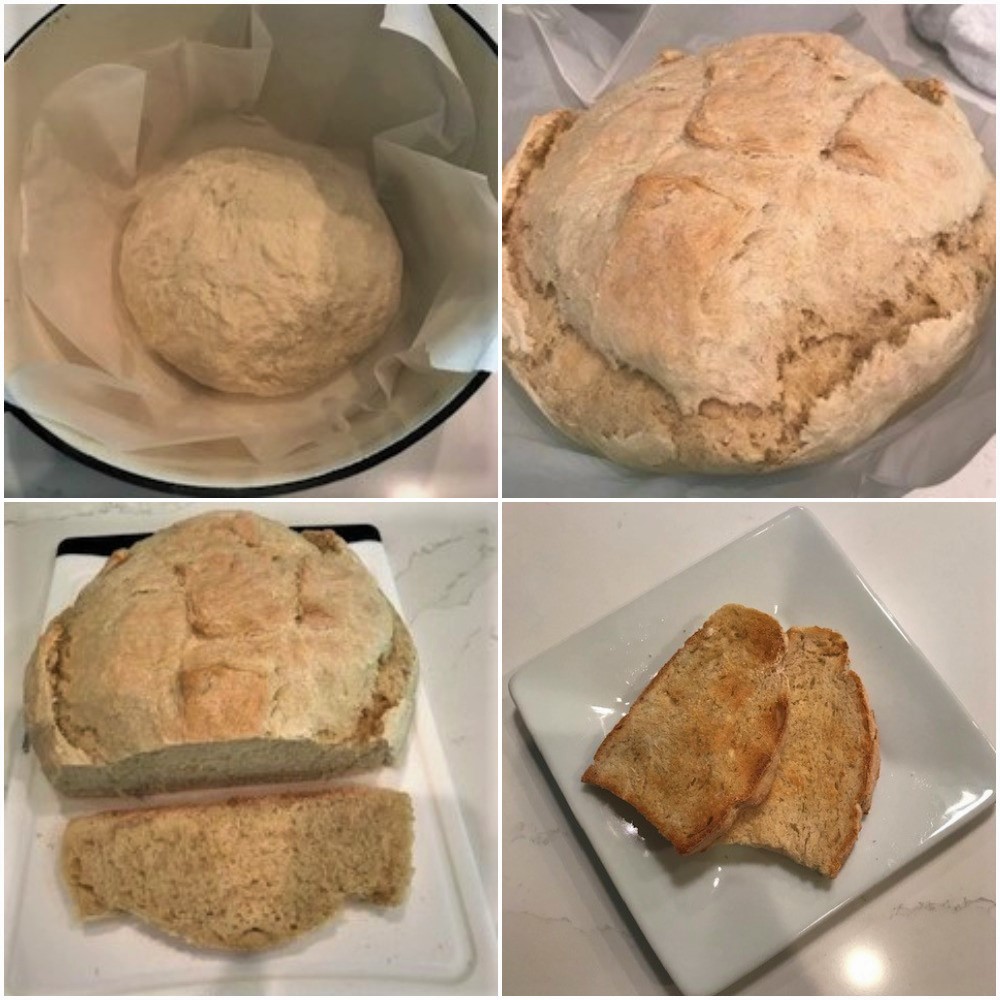
This flavorful bread is made with only five ingredients and is baked in a Dutch Oven. Finished loaf is slightly grainy inside, with a medium firm texture, easy to slice, and makes great toast. Tanned on the outside as shown results in perfectly crisped crust.
I wanted to create a delicious bread using the same simple ingredients as my “Basic Everyday Bread” but baked in a Dutch oven. Assuming most casual bakers don’t have access to live sour dough starter, I also wanted a flavorful recipe that didn’t require it. After several tweaks, the third using 400° direct heat cooked perfect in and out.
Like all my other quick and easy bread recipes, first stage creates a light and thinner dough that’s exceptionally convenient to work with. Once assembled, it’s easily mixed by hand in a bowl only with a spatula. It also rises quickly, doubling its volume in under a half hour.
Once risen remaining flour is incorporated with the dough, kneaded until smooth then formed into a ball. Dough is placed in the Dutch oven lined with parchment.
Ingredients:
- 2 cups hot tap water
- 1 teaspoon sugar
- 1 tablespoon instant dry yeast
- 1 rounded tablespoon Kosher salt
- 3 plus 2 cups unbleached all-purpose flour
Utensils
- Approx. 7-quart Dutch oven
- Parchment paper
- Dough scraper
- Sharp knife
Line bottom and sides of Dutch oven with parchment paper. Roughly smooth creases. Weight of the dough will hold parchment in place.
Whisk water, sugar, instant yeast, and salt in a large bowl. Add 3 cups of the flour. Mix by hand with a spatula until smooth. Loosely top with wax paper sprayed with nonstick facing dough. Top with a towel moistened with warm water. Place bowl in a warm location.
Preheat oven to 400° direct heat.
Place remaining 2 cups of flour on working surface. When dough doubles in size, empty onto flour. With the aid of a dough scraper, combine and knead smooth. Form into a ball.
Place dough into the Dutch oven. Score top of dough with a sharp knife or razor blade and place uncovered Dutch oven in the oven.
Bread is ready when crust is crisp, about 30 to 40 minutes and bottom of bread sounds hollow when tapped.
.jpg)
- ½ cup raw hulled Farro grains
- 1 ½ cups water
- 2 Tablespoons instant dry yeast
- 2 ½ cups hot tap water
- 1 Tablespoon honey
- 1 Tablespoon dark brown sugar
- 1 tablespoon Kosher salt
- ½ cup sour dough starter
- 1 cup whole wheat flour
- ½ cup rye flour
- 4 cups unbleached flour separated into 2 ½ cups and 1 ½ cups
.jpg)
- ¼ dough from basic everyday bread recipe above
- 5-6 garlic cloves from Pete’s Garlic Oil, recipe below
- ¾ cup shredded Italian cheese blend
- ½ cup shredded parmigiana cheese
- 5-6 large garlic cloves
- 2-inch sprig fresh rosemary
- 3-4 fresh sage leaves
- Pinch red pepper flakes
- ¼ teaspoon kosher salt
- Olive Oil
- ¾ cup olive muffuletta; rosemary and sage from Pete’s Garlic Oil.
- ¾ cup sun dried tomato in oil coarsely chopped; sliced fresh basil
- 3 oz. shredded prosciutto or finely cubed; drizzle olive oil from Pete’s Garlic Oil
- Spread olive muffuletta and coarsely chopped rosemary needles and sage from Garlic Oil.
- Add sun dried tomato and sliced basil.
- Add shredded or finely cubed prosciutto. Lightly drizzle olive oil from Pete’s Garlic Oil
- 3 ½ cups boiling water
- 2 cups rolled oats
- 1 ½ tablespoon light brown sugar
- 2 ½ tablespoons active dry yeast
- 1 ½ tablespoons salt
- 2 tablespoons honey
- 3 tablespoons olive oil
- 1 cup rye flour
- 3-4 cups unbleached all-purpose flour
- More flour as needed
- 2 Loaf pans approx. 5”x10”
- 1 medium-large russet potato peeled (about 1 1/4 cups cooked)
- Water
- 2 tablespoons dry yeast
- 1 tablespoon salt
- 1 tablespoon sugar
- About 6 cups unbleached wheat flour
-9bf31.jpg)
Dinner rolls are made with southern style biscuit batter conveniently mixed in a food processor or mixer with dough hook. Once combined, formed into a log on a counter dusted with flour, shaped and baked.
Dry Ingredients:
- 3-cups flour
- 1 scant tablespoon Kosher salt
- 1 tablespoon baking powder
- 1/2 teaspoon cream of tarter
Creamed Butter:
- 1 stick unsalted butter
- 1 ½ tablespoon sugar
Buttermilk:
- 1 ½ cups buttermilk
- 1 teaspoon baking soda
Preheat oven to 450°
Whisk “Dry Ingredient” in a bowl.
Cream butter and sugar in food processor.
Add dry ingredients and pulsate until combined.
Pour in buttermilk and baking soda. Mix until smooth. Batter will be sticky.
Dust counter with flour. Remove batter with a spatula and place on flour. Flip with a pastry scraper to dust all sides. With fingers form into a log. Cut pieces with scrapers, roll in flour and form into balls or football shapes in hand.
Place in a cookie sheet lined with ungreased parchment or nonstick foil. Bake until lightly tanned about 10 minutes or so.
Optional, lightly brush tops with melted butter before baking. Surfaces will be softer, cooking times slightly longer.
Southern Cheddar Cheese Biscuit Rolls
-8f14e.jpg)
Makes about a dozen biscuits.
Follow recipe above. After mixing buttermilk and baking soda, pulsate with 2 cups of shredded cheddar. If needed, thin with additional buttermilk.
Continue with instructions above for shaping and baking.
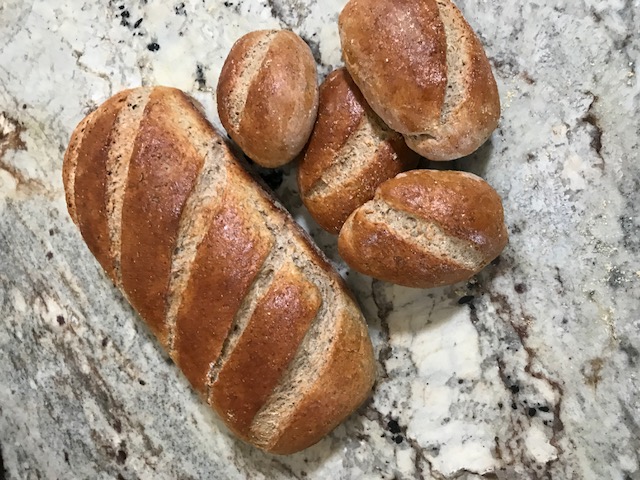
- 1 cup hot tap water
- 1 cup warmed whole milk
- 2 tablespoon instant dry yeast
- ¼ cup honey
- 2 tablespoons butter softened or melted
- 1 tablespoon caraway seeds
- 1 heaping tablespoon salt
- 2 ½ cup rye flour
- 2 ½ to 3 cup unbleached wheat flour
- One egg white
- 2 tablespoons water
- Russet potatoes, enough to yield 1 cup mashed
- Water
- 1 cup buttermilk at room temperature
- 3 tablespoons melted butter
- 3 Tablespoons honey
- 1 Tablespoon caraway seeds
- 1 Generous tablespoon salt
- 2 tablespoons yeast
- 2 ½ cups rye flour
- 3 ½ cups unbleached all-purpose flour
